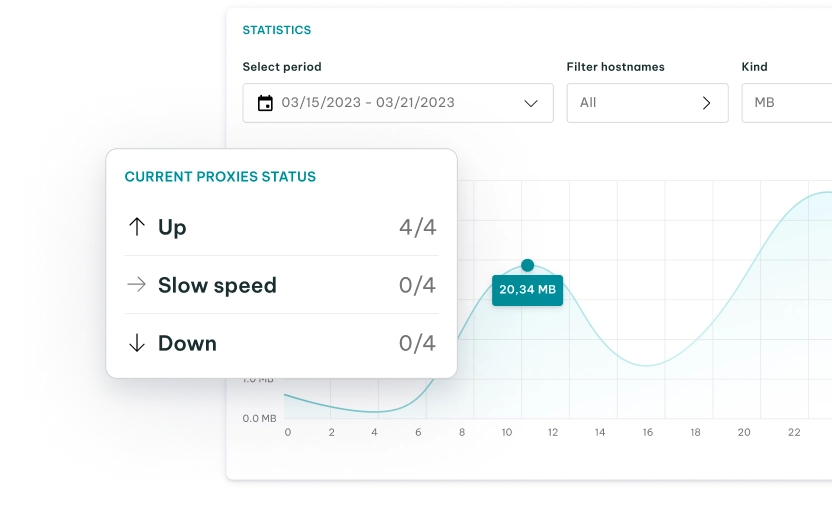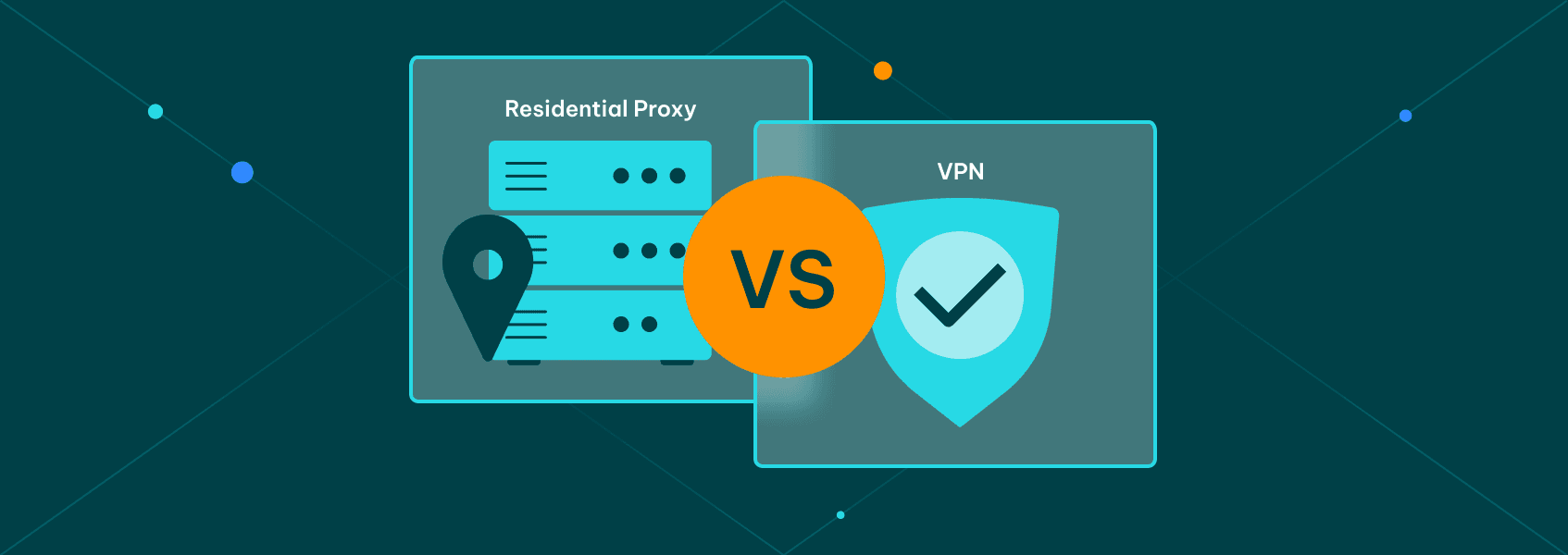How to Bypass CAPTCHA (2025 Guide): 6 Working Methods
Proxy fundamentals

Vilius Dumcius
CAPTCHA (Completely Automated Public Turing test to tell Computers and Humans Apart) is a commonly used method to prevent automated access to websites and applications. While usually reserved for bots, these can also be triggered during regular browsing.
Humans can generally solve CAPTCHAs without major issues. They become a major problem whenever you’re trying to perform automated actions, most commonly web scraping. Since the process sends a large number of requests per minute, triggering a CAPTCHA is almost inevitable.
How Does a CAPTCHA Work?
A CAPTCHA is displayed whenever a website or application encounters what it deems as suspicious users. Usually, the suspicion is regarded as sending too many requests in a short amount of time.
As CAPTCHA serves as a method to detect bots and prevent them from accessing the website, a CAPTCHA will either display a completely different web page or forbid the user from moving forward with their action (such as stopping a registration) until the test is solved.
Most bots have issues reading images, so most CAPTCHAs involve visual content in one way or another. Solving CAPTCHAs usually involves selecting matching images (such as fire hydrants) or reading scrambled text displayed in a visual format.
Developing solutions for CAPTCHAs, while not impossible, is often expensive or difficult. As such, the best way to bypass CAPTCHA is to avoid it by using other, cheaper solutions.
How to Avoid CAPTCHA Tests
If your automated solution often triggers CAPTCHAs, developing a CAPTCHA solver shouldn’t be the first course of action. You can optimize other areas to reduce the likelihood of triggering one.
1. Use Proxies
The easiest way to bypass CAPTCHA is to use proxies. Every CAPTCHA is served to an IP address, which is allowed to continue browsing whenever the test is solved.
So, switching your IP address through a proxy is an easy way to bypass CAPTCHA challenges. With access to a decently-sized residential proxy pool , you’ll be able to minimize the impact of CAPTCHAs.
While you can use a datacenter proxy pool for the same purpose, the way IP addresses are acquired (i.e., from business-owned data centers) makes them more suspicious by default, which can result in an IP ban .
In turn, that makes them more likely to receive a CAPTCHA on some websites, while a handful of them may block datacenter IPs outright.
2. Improve Your Web Scraping Methods and Browser’s Fingerprint
On the other side of the coin, another way to bypass CAPTCHA challenges is to minimize the suspicion of your automated actions. While you cannot make them entirely unsuspicious, you can make each IP address last a lot longer before you get a CAPTCHA.
Two major ways are improving your browser’s fingerprint and working around known detection methods. Improving a browser’s fingerprint generally revolves around picking popular user agents and other HTTP headers used by a lot of regular users across the internet.
Unfortunately, there’s no one weird trick — you’ll have to experiment by taking the most popular user agents and testing them in the field. But with enough data, you’ll be able to minimize suspicion.
Finally, you can experiment with various ways of accessing the website. Common suggestions include increasing wait times between requests, changing the browsing path (e.g., visiting the home page first and then moving to other parts of the website), etc.
Most websites will have different levels of stringency regarding when to assign a CAPTCHA, so the most effective web scraping methods will differ slightly as well.
How to Solve CAPTCHA Tests
Unfortunately, there are no good materials out there on how to block CAPTCHA challenges entirely. However, you can take steps to bypass CAPTCHAs once you get them. If avoiding them becomes problematic, building or using a CAPTCHA solver is the next best solution.
1. Use Browser Automation Extensions or Libraries
Depending on your implementation, there may be additional tools available that will help you bypass CAPTCHA tests by default. Most popular web scraping runtimes and languages (e.g., Node.js; Python) will have libraries dedicated to avoiding CAPTCHAs.
For example, Python has a GoodByeCAPTCHA library that attempts to solve the tests through various APIs. While far from perfect, it’s a good starting point as it’s a free and easy-to-integrate CAPTCHA solver.
2. Develop an Optical Character Recognition (OCR) Algorithm
For visual CAPTCHA tests, you could potentially develop an OCR algorithm that’s based on machine learning. It’s one of the most difficult solutions to the problem and enough to be a project in and of itself, but it could be extremely effective.
Unfortunately, it’s somewhat limited in scope as OCR can only solve visual CAPTCHAs, so you’d have to combine it with other solutions.
3. Use CAPTCHA-solving Services
There are a ton of CAPTCHA-solving companies and services all over the internet. Most of them use a per-X-CAPTCHA-solved fee structure, meaning you pay some amount of money for 100 or 1,000 tests solved.
These companies work through implementing their API, which forwards them CAPTCHAs each time you receive one when doing web scraping. For smaller projects, the costs can be relatively small but may become unsustainable for larger ventures.
If you decide to use such a service, make sure to optimize your web scraping strategy to minimize the likelihood of getting a CAPTCHA. It’ll greatly reduce the amount of money you have to spend in the long run.
4. Manually Solve CAPTCHAs
Finally, for smaller projects and non-commercial use, manually solving a CAPTCHA every once in a while is another option. It won’t work for anything other than a homebrew project, but it remains an option.
Free vs Paid CAPTCHA Bypass Tools in 2025
In the cat-and-mouse game of CAPTCHA challenges vs solvers, there are some tools you can choose from to help you out.
Free CAPTCHA Bypass Tools
GoodByeCaptcha (Python) and Buster: CAPTCHA Solver for Humans (Chrome/Firefox extension) are two decent CAPTCHA solver tools that you can use if you don’t want to spend money on any solutions.
Pros:
- Zero cost
- Great for small web scraping tasks
- Open-source or easy browser add-ons
Cons:
- Slower solving speed
- Can’t properly handle advanced image-based CAPTCHAs or modern behavioral CAPTCHAs
- Not very reliable for large-scale web scraping
Paid CAPTCHA Solvers
2Captcha and Capsolver are two premium tools you can use to bypass CAPTCHAs. You may want to opt for these if you’re more serious about scraping data and want to automate some web scraping processes more efficiently.
Pros:
- Fast response times
- Supports all major CAPTCHA challenges: image-based CAPTCHAs, text-based CAPTCHAs, and more
- Offers API integration for high-volume web scraping tasks
Cons:
- Costs can add up, especially with frequent web scraping jobs
- Requires setup and API key management
If you’re running a project where you need to constantly bypass CAPTCHA challenges or you’re doing large-scale web scraping, paid options usually offer better results. But for testing or low-volume usage, free tools can be fine.
It’s highly recommended, however, to adopt various CAPTCHA frequency reduction techniques if you plan on using paid services. They usually charge per CAPTCHA solved, so you’d greatly reduce your costs if the preceding pipeline (i.e., until a CAPTCHA appears) is optimized.
CAPTCHA Bypass Trends and Techniques for 2025
As more websites deploy smarter CAPTCHA challenges, traditional methods to bypass CAPTCHA are constantly hitting new roadblocks. Modern CAPTCHAs are no longer just image-based CAPTCHAs or text-based CAPTCHA puzzles.
In 2025, there’s a rise in more complex security mechanisms that focus on behavioral detection and AI-powered checks.
Here are some major developments:
- Invisible reCAPTCHA v3. It works silently in the background and assigns a risk score based on user behavior. No challenge appears unless you fail the score.
- hCAPTCHA evolution. It now includes more imaged-based CAPTCHAs, dynamic puzzles, and sometimes even text-based CAPTCHA elements.
- Behavioral CAPTCHAs. They monitor how you move your mouse, scroll, or interact with elements.
- Bot behavior analysis. Uses artificial intelligence to evaluate how human-like the user’s browsing is.
These new CAPTCHA challenges are much harder to fool with simple tools. However, several techniques can still work depending on the type you’re facing.
CAPTCHA Types vs Bypass Techniques
| CAPTCHA Type | Description | Bypass techniques |
|---|---|---|
| Image-based CAPTCHAs | Click matching images (e.g., traffic lights) | Use OCR tools, CAPTCHA-solving APIs, or proxy rotation |
| Text-based CAPTCHAs | Distorted or scrambled text | OCR with machine learning, audio CAPTCHA fallback, or manual solving |
| Behavior-based CAPTCHAs | Looks at behavior (click speed, scrolling, etc.) | Use headless browsers with human-mimicking behavior scripts |
| Invisible CAPTCHAs | Scores behavior in the background | Mimic human traffic with real device/browser fingerprints, reduce request speed |
| Audio CAPTCHAs | Speaking or listening-based puzzles | Use speech-to-text APIs or send audio to human solver services |
Keeping up with these changes is key if you’re doing large web scraping tasks.
Wrapping Up
All six methods are valid and viable solutions for how to bypass CAPTCHA challenges. It’s best if you combine some of them with others, such as using proxies at all times while maintaining good fingerprints. For many use cases, proxies and optimized web scraping will be enough to get all of the data you need. If a particular resource is especially stringent or troublesome, use a solving service to bypass CAPTCHA and supplement your existing pipeline.
FAQ
Is it legal to bypass CAPTCHA challenges?
Using a CAPTCHA solver isn’t illegal by itself, but using it to scrape data from a site that forbids it in their terms of service could land you in trouble.
Some sites may treat it as unauthorized access, especially if it’s linked to malicious bots. So, it’s fine to avoid CAPTCHA as long as you’re not doing anything illegal afterwards.
What is the most accurate CAPTCHA-solving API in 2025?
2Captcha and Capsolver are great options for accurate solving of image-based CAPTCHAs, text-based CAPTCHAs, and more. However, behavior-based puzzles and other more advanced types may be a little tricker. Anyhow, these two tools handle a variety of CAPTCHA challenges and adapt quickly.
How do paid CAPTCHA solvers compare to free ones?
Paid solvers offer higher accuracy, especially with newer CAPTCHAs, they work faster and handle more CAPTCHA types, including text-based CAPTCHA and image-based CAPTCHAs.
Free solvers are good for small projects, but they often fail and struggle with new CAPTCHAs. If you’re serious about web scraping, you may be better off with a paid solution.



